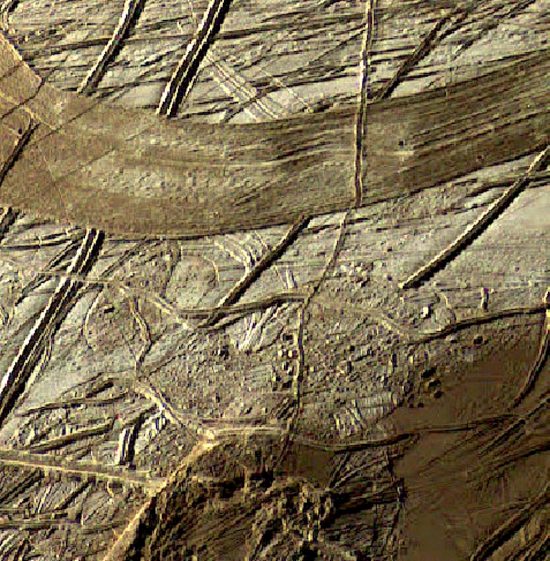
Nov 20, 2019
Europa is thought to harbor liquid water beneath its surface.
Jupiter’s environment was visited by nine different space probes, beginning with Pioneer 10 in 1973; with the Juno mission the most recent. Out of its 79 known moons, the four Galilean moons (named after Galileo Galilei, who, along with Simon Marius, discovered them in 1610) are the most well-known.
The Galileo spacecraft was launched on October 18, 1989 from the Space Shuttle Atlantis, and subsequently entered orbit around Jupiter on December 7, 1995. After eight years in orbit, Galileo was deliberately incinerated by sending into the atmosphere of Jupiter on September 21, 2003. This was done to prevent any materials from its body accidentally contaminating Jupiter’s moons, especially Europa.
Europa is extremely cold, with a mean temperature of −160 C at the equator and −220 C in its polar latitudes. At that temperature, water ice has a tensile strength equivalent to crucible steel.
According to a recent press release, planetary scientists speculate that, even though it is so cold, Europa might harbor liquid water. They believe that beneath the ice-rock crust, the moon could have a relatively warm ocean. Conventional interpretations suggest that Europa’s heat comes from “tidal kneading”: Jupiter’s gravity is said to stretch and compress the moon, creating internal friction that forms small pockets of liquid water in lakes beneath the surface, above a salty ocean. Although, NASA scientists also say: “Even the existence of a subsurface ocean, while strongly suspected, is not yet proven.”
As written previously, Europa’s surface is a thought to be a multi-kilometer deep shell of water ice floating on a salty sea. The “decoupled” surface undergoes periodic deformation because movement creates stress cracks, allowing gigantic rafts to form. However, high resolution cameras reveal smoothly cut channels that do not look like fractures. Their orientation disregards prior channels, sometimes with five or six of them stacked on top of each other at every angle. As electrical experiments in Dr. C. J. Ransom’s Vemasat Laboratories reveal, this should come as no surprise. Electric currents flowing across a conductive surface are “pinched” into thin filaments by their associated magnetic fields and draw other filaments into parallel alignment. The trackways often overlap each other.
When electric arcs strike a sphere, smaller, perpendicular side channels are created by corona discharges. Darkened, scorched areas, pits, curving channels that appear to be centered on Europa’s poles, and a lack of craters are all duplicated in Vemasat experiments. NASA’s surprises are expected by Electric Universe advocates because plasma behavior scales by many orders of magnitude. From the laboratory to the Solar System’s planets and moons, plasma is the primary ingredient that shapes worlds, not kinetic squeezing and stretching. There is most likely no subsurface ocean on Europa, and the chaotic terrain is surface features that do not result from interior processes.
Stephen Smith
The Thunderbolts Picture of the Day is generously supported by the Mainwaring Archive Foundation.












